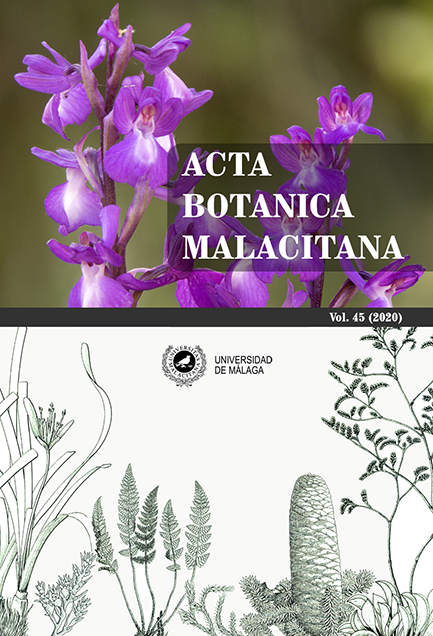Rediscovery and Ecology of Onopordum algeriense(Munby )Pomel = Carduus algeriensisMunby,astrictendemicspeciesin the process of extinctionof the Algerian sector
DOI:
https://doi.org/10.24310/abm.v45i.5805Keywords:
Carduus algeriensis, Onopordon algeriense, endémisme, rare, extinction, Algérie, AfriqueAbstract
Onopordum algeriense is a strict endemic species of the Algerian sector, limited more precisely to the hills and mountains of the Puits des Zouaves (Baïnem Forest). Given its very restricted distribution its conservation is essential. It is indeed strictly protected in Algeria by Executive Decree.
The objective of this paper is to assess the population size and conservation status of Onopordum algeriense according to IUCN criteria as well as its vulnerability. Exhaustive sampling by the quadrat method was carried out in two sites in the Baïnem forest.
In order to study the spatial distribution of the species, the method of Thiessen Polygons and Moran Index followed by a canonical correlation analysis was applied to elucidate the relationship between the environment variables and the spatial distribution of the species. The results revealed a trend towards aggregation.
The population has a reduce size (1648 feet by 320 m2). Onopordum algeriense seems to be disturbed by the presence of wild boar and probably also by the presence of a beetle (the evil ketone). The particular conditions of its natural habitat do not seem indispensable to its survival but the absence of competitors in this habitat will, no doubt, represent a strong advantage. According to the adopted IUCN criteria, the species is Critically Endangered. If there is not conservation effort the future of the species seems uncertain also because of the pressure for urbanization in this area.
Downloads
Metrics
References
Baumel, A., Affre L., Véla E., Auda P., Torre F., Youssef S., Tatoni T. (2009). Ecological magni-tude and fine scale dynamics of the Mediterranean narrow endemic therophyte, Arenaria provincialis (Caryophyllaceae). Acta Botanica Gallica 156: 259-272.
Faurel, L., (1959). Plantes rares et menacées d’Algérie. C. R. de la réunion technique de l’UICN, 5, 140-155. Athènes.
Fortin, M. J., Dale, M. R. T. (2005). Spatial analysis: A guide for ecologists. Cambridge Univ. Press, 365 p. ISL-BRGM (2006) . Etude de réduction de la vulnérabilité du massif de Bouzaréah aux catas-trophes naturelles. Rapport de tâche 2, volume 2, R3114, 6-42.
IUCN (2018). Guide pratique pour la re?alisation de Listes rouges re?gionales des espe ces menace?es - Me?thodologie de l’UICN & de?marche d’e?labora-tion. Seconde édition. Paris, France.
Médail, F., Myers, N. (2004). Mediterranean Basin, in: R.A. Mittermeier, P. Robles Gil, M. Hoffmann, J. Pilgrim, T. Brooks, C.G. Mitter-meier, J. Lamoreux, G.A.B. da Fonseca (Eds.), Hotspots revisi-ted: Earth’s Biologically Richest and Most Endangered Terres-trial Ecoregions, CEMEX, Conservation International & Agru-pación Sierra Madre, Monte-rrey, Washington, Mexico, 144–147
Petit, R. J., Aguinagalde, I., Beaulieu de, J-L., Bittkau, C., Brewer, S., Cheddadi, R., Ennos, R., Fineschi, S., Grivet, D., Lascoux, M., Mohanty, A., Mu?ller-Starck ,G., Demesure-Musch, B., Palmé, A., Martin, J. P., Rendell, S. & Vendramin, G. G. (2003). Glacial refugia: hot spots but not melting pots of genetic diversity, Science, 300, 1563-1565.
Quézel, P. & Médail, F. (2003). Écologie et biogéogra-phie des forêts du Bassin méditerranéen, Elsevier, Paris. 573 pp.
Véla, E., Auda, P., Léger, J. F., Gonçalves, V., Baumel, A. (2008). Exemple d’une nouvelle évaluation du statut de menace suivant les critères de l’UICN version 3.1.: le cas de l’endémique proven-çale Arenaria provincialis Chater & Halliday (= Gouffeia arenarioides DC., Caryophyllaceae). Acta Botanica Gallica 155: 547-562.
Vela, E. & Benhouhou, S. (2007). Évaluation d’un nouveau point chaud de biodiversité végétale dans le Bassin méditerranéen (Afrique du Nord). Comptes-Rendus Biologies, 330, 589-605.
Youssef, S., Baumel, A., Véla, E., Juin, M., Dumas, E., Affre, L., Tatoni, T. (2011). Factors underlying the narrow distribution of the Mediterranean annual plant Arenaria provincialis (Caryophy-llaceae). Folia Geobotanica published online 25 Mai 2011.
Zuur, A. F., Ieno, E.N., Smith, G.M., (2007). Analysing ecological data. Springer, New York. 672p
Downloads
Published
How to Cite
Issue
Section
License
Copyright (c) 2020 Acta Botanica Malacitana

This work is licensed under a Creative Commons Attribution-NonCommercial-ShareAlike 4.0 International License.
All information related to the licensing of published works in Acta Botanica Malacitana and copyright can be found in our Editorial Policy.







1.png)
